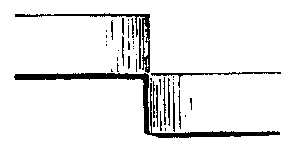Fesse
Fesse

Fesse, sometimes spelt fess, (fr. fasce): one of the ordinaries, and though not found so frequently perhaps as the bend, it is used as much as the chevron, and if its kindred charge(for this in not allowed to be a diminutive), the bar is taken into account more so. It is the most natural form to be produced in the construction of a shield, though fanciful heralds find an origin for it in the military girdle. It should occupy, according to heraldic rule, one third of the height of the escutcheon, but this proportion is almost always considerably diminished in practice. Its position is across the centre of the shield, unless it is described as enhanced, or abased.
Walter de COLEVILLE, dor ung fece de goulz--Roll, temp. HEN. III.
Le Counte de WARWICK de goules crusule de or, a une fesse de or--Roll, temp. ED. II.
Monsire Symon de COLVIL, porte d'or a une fes de gules.
The fesse is subjected to the same series of variations as to its margin as have already been noted under the bend, &c., and this from earliest times; the fesse dancetty was called a dauncet, and when indented q.v. the number of indentations is sometimes given. It is found humetty(q.v.) and even with the ends botonny.
Piers PERCY, d'or ung fece engrele d'azur--Roll, temp. HEN. III.
John de DEYVILLE, d'or ung fece flourey de l'un en l'autre--Ibid.
Argent, a fesse botonny gules--ABIBSON.
There cannot properly be more than one fesse in a single coat of arms; if more they are bars; but still, in rare instances, in old blazoning the term fesse is used where bar would be used now; the term a demi-fesse occurs also when it is joined with a canton. (See under Canton, arms of PYPARD.)
Sir John de WAKE, port d'or ov ij fesse de gulez ov iij torteus d'or en la chef.--Falkirk Roll, A.D. 1298, HARL. MS. [But in the Roll in the Cottonian MS. Caligula, A. xviii. A.D. 1308-14, these arms are blazoned, Sire Johan WAKE, de or, a ij barres de goules, en le chef iij rondels de goules].
Sir Rauff PIPART, porte d'argent ov ung fees et demy fees et le cantell d'azure; et en le cantell quint foyl d'or--Falkirk Roll, Harl. MS. 6589.
Again, like the chevron, the fesse may be abased, enhanced, &c.
Argent, a fesse enhanced and a chevron gules--MACK.

And it may be debruised or broken, when it would probably be represented as in the margin; though there is much doubt as to the practical application of such terms as debruised, fracted, &c., as has been shewn under the terms bend, chevron, and downset.
Gules, a fesse removed or debruised in the centre argent--BROKROSE.
It may be charged with various devices, and very rarely is it depressed by other ordinaries, but such cases do occur.
Gules, a fesse ermine depressed by a pale of the same within a bordure engrailed azure--SPONNE.
Or, a fesse chequy azure and argent, over all a bend engrailed gules within a bordure of the third charged with eight mullets of the second--STUART, co. Oxon.
Party per fesse(fr. coupé) is very rare in comparison with party per pale. While the division into three horizontal portions(fr. tiercé), though comparatively common in French arms, is seldom if ever found in English examples. See Party.
Fesswise, or fessways, is used to signify that a charge, the normal position of which is upright, is placed lengthways.
Gules, a sword lying fesswise proper, hilt and pomel or, the hilt towards the sinister between three fleur-de-lis of the last--BROWNE, Scotland.

Fesse-wards signifies that the charge, or charges, are to be placed with the heads or points towards the centre of the shield, i.e. the fesse-point.
Sable, a close helmet between three spear-heads, points fesse-wards--DOLBEN, Bp. of Bangor, 1632.
Please Help!
DrawShield is a Free service supported by its users.

If you can, please help cover the cost of the server, or just buy the team a coffee to say thanks!
 Buy me a coffee
Buy me a coffee


